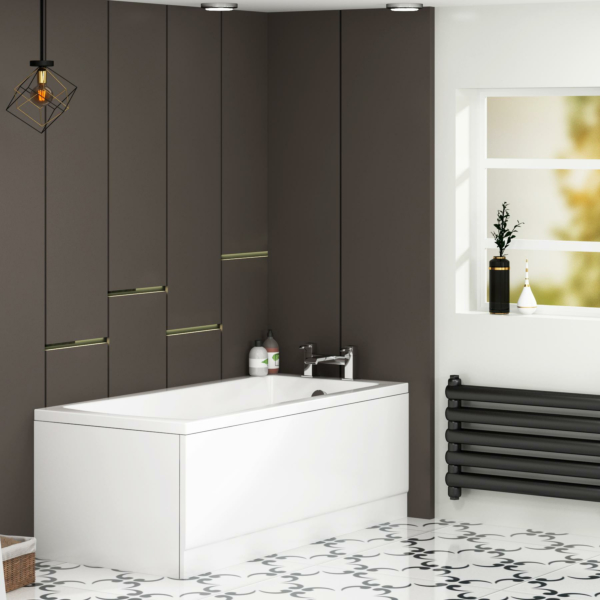Redesigning your bathroom can be an overwhelming experience. It may also involve getting various fittings and fixtures like a new Standard Bath. However, you will soon realize after starting to look for a new bath that the most important factor when choosing a bath is its material. Standard Bathtubs come in various materials like porcelain, acrylic, fiberglass, and cultured marble, but which one should you prefer over another? Though each material has its pros and cons, it is important to know which one is a better option than the other. In this article, we are going to compare standard bath materials in terms of heat retention, durability, weight, cost, and ease of installation.
- Heat Retention of Standard Bath material
Each material offers its own benefits and drawbacks when it comes to heat retention. Porcelain is one of the classics for bathtub material and provides great durability and heat retention thanks to its porosity. Acrylic is another popular option due to its lightweight properties and durability; however, it also retains hot water heaters but not that much compared to other materials.
Finally, although they can be expensive and occasionally fragile, stone baths offer excellent. That’s what makes them well worth the potential cost and upkeep. So, for a standard bath that retains well-temperature water, fiberglass and marbles are worth suggesting materials. But acrylic is not too bad at it. The acrylic baths available in the market are pretty much comparable to others in heat retention. Read through our guide on how to qualify for a free insulation grant.
- Durability (Scratch and Crack Resistant)
When it comes to choosing a bathtub material, durability must be taken into consideration. Porcelain, the oldest and longest-lasting of tub materials, is highly resistant to scratches and cracks. Though somewhat heavier than other materials and more expensive to maintain, porcelain can last for generations when properly cared for.
Acrylic standard bath is also a popular choice for many bathrooms as it is lightweight yet also reasonably durable. It is far less prone to cracking compared to porcelain and generally cheaper too but can scratch more easily. For further durability options, fiberglass or culture marble may be an alternate choice. Fiberglass offers ease of use and the ability to maintain its shape with little maintenance; however, it is fairly susceptible to damage from impact and chemical cleaners. Cultured marble lacks strength in comparison, but it offers a limited degree of scratch resistance and may require fewer repairs in the long run due to its strong seal finish.
- Weight
The weight of bathtub material is an important factor to take into consideration when choosing the right one for a home. Porcelain is extremely durable and lightweight, making it among the most popular choices for bathrooms. Acrylic standard bath is lighter than porcelain but still very strong, allowing for freestanding and fitted designs and easy cleaning. Fiberglass is often used for more modern designs due to its flexibility, making it easier to achieve intricate shapes without sacrificing durability. Cultured marble is often the least heavy product but can come in a variety of finishes. Although the material’s porosity may require some additional maintenance when compared to other products, its low weight makes it an ideal choice for larger tubs or bathtubs situated on higher stories.
- Cost of Standard Bath Based on Material
When it comes to standard bath costs, porcelain is typically the most expensive of these materials due to its durability. It is because anything with porcelain can last up to two or three decades with proper care and maintenance. Acrylic standard bath is best known for its lightweight and sleek design; it’s also easier to repair than other materials should something break. The advantage of acrylic is that it’s the most economical material of all. Fiberglass has been around since the 1940s due to its malleability and flexibility during manufacturing. Though culture marble combines several synthetic rivals along with the crushed stone. Which allows it to mimic higher-end materials while being less expensive and more water resistant. Ultimately, each type of bathtub material offers distinct advantages based on budget, design considerations, and desired longevity.
- Installation and Maintenance of Standard Bath Based on Material
Porcelain is one of the most popular materials due to its durability and classic look. However, porcelain requires extensive installation work and regular maintenance such as sealing the walls and surfaces with coatings like glaze to keep it looking pristine. Acrylic standard bath is another good choice because of their flexibility and affordability; however, it is not as durable as porcelain and may require repairs or replacement over time. However, it is very popular and common for baths due to its lower durability value.
Fiberglass is lightweight but also prone to scratches, dents, and cracking over time. For those looking for an option that does not require much maintenance, culture marble may be an option. Although more expensive than acrylic tubs, culture marble offers an easy-to-maintain glossy surface that also resists staining and discoloration from oils or hot water.
Bottom Line
Every standard bath material has its pros and cons. It all depends on you which of the above-discussed elements is a higher priority. Acrylic standard bathtubs are a popular choice nowadays due to their lower price, reasonable durability, lightweight, and easier installation. Ultimately, the material selection should come down to each buyer’s individual needs and preferences while factoring in long-term use and maintenance costs.
